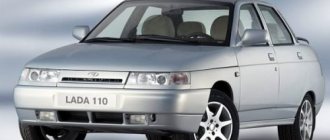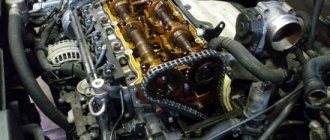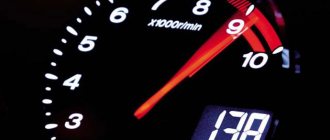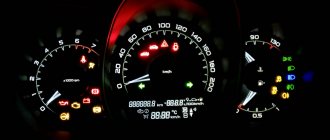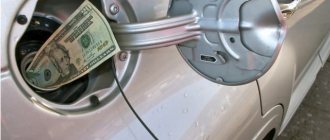The most popular “classic”, the VAZ 2107 model, first rolled off the assembly line in 1982. It differed from previous models in its richer equipment, comfort, and modern appearance. The car was equipped with gasoline engines of various sizes with a manual transmission. They are all different:
- reliability;
- maintainability;
- efficiency;
- long engine life;
- constructive simplicity.
Due to its high popularity, the car was produced for more than 30 years. To reduce the engine's appetite, injectors began to be installed on the VAZ 2107, which made it possible to significantly reduce fuel consumption by 100 km.
Engine 1.3 with carburetor
The most affordable modification was equipped with a 1.3 engine with 64 horsepower, which accelerated the car to hundreds in 18 seconds and a top speed of 145 km/h. Its fuel consumption is:
- in the city 11.5 l;
- mixed mode 10.5 l;
- on the highway 7.8 liters.
The car is fueled with AI 92 gasoline. Some owners complain about the high fuel consumption of the VAZ 2107 with a carburetor, the reasons for which are incorrect settings of the gasoline supply system. Cleaning and proper adjustment will allow you to bring consumption indicators to the passport standards.
For the special services of the USSR, they produced a version of the 1.3 rotary-piston type engine with 135 horsepower, it has the same gas consumption, but is practically not found. The complexity of the design makes it difficult to operate.
Cost according to reviews
- Ivan, Moscow region. I still drive a 1987 VAZ 2107 with a 1.3 engine and rear wheel drive. The engine pulls decently, is very reliable and does not pay attention to the quality of gasoline. For such a car, fuel consumption is, of course, high - 10 liters all round, but this is a Soviet classic.
- Alexander, Smolensk. I have owned a VAZ 2107 for almost 30 years and don’t want any other car. The 1.3 engine is very reliable, subject to proper care and normal operation. The suspension is adapted to our roads, and rear-wheel drive control is a matter of habit. Consumption fully corresponds to the passport - highway 7 liters of gasoline, if you drive at a speed of 90 km/h, city - 11.
- Vladimir, Ryazan. My father has been driving a 7 for many years and considers it the best car in the world. The 1.3 engine with 64 horsepower is extremely reliable, especially if you don’t drive it too hard, and it does the repairs yourself; spare parts are inexpensive. Average gasoline consumption is 10 liters, which is the optimal indicator.
Reasons for overspending
Let's start with the fact that in practice this car can consume different amounts of fuel, ranging from 7 to 11.5 liters. This depends on what volume it has, as well as on the modification of the motor itself. The main reasons why a carburetor or power unit with distributed fuel injection begins to consume more fuel are the following phenomena:
- the appearance of deposits on the walls of the nozzles, which leads to a change in their internal cross-section;
- excessively clogged air filter element;
- breakdown of sensors responsible for distributed fuel injection;
- incorrect heat rating on the spark plugs or excessive carbon deposits;
- dynamic driving style;
- cold frosty weather, since winter consumption is traditionally higher than in summer.
Engine 1.5 with injector
More powerful modifications of the VAZ 2107 were equipped with a 1.5 engine, with powers of 68 and 72 horsepower. These cars were originally produced with carburetors, but over time they were replaced by injectors. With a five-speed manual transmission, the car accelerated to hundreds in 17 seconds, and the maximum speed reached 150 km/h.
Fuel consumption for both trim levels was stated to be similar:
- on city streets 8.9 l;
- in a mixed cycle 8.5 l;
- on the highway 7.4 liters.
Installing an injector made it possible to significantly reduce fuel consumption, but its consumption is also affected by the condition of the injectors, the quality of gasoline and other factors.
Fuel consumption per 100 km – reviews
- Bogdan, Kerch. If you need a simple and reliable car for a novice driver, the VAZ 2107 is an excellent option. Quite comfortable, it forgives mistakes in handling, the 1.5 engine is reliable and elastic, the suspension is perfectly adapted to our roads. You can refuel with any gasoline, no problems are observed in the fuel system. In the city cycle the engine takes 9.5 liters, on the highway you can keep within 7.5.
- Valery, Naberezhnye Chelny. I bought a VAZ 2107 on the secondary market in 2012. This car has absolutely nothing to worry about: the engine can easily digest any gasoline, the suspension feels great on smooth roads and bumps, and the manual transmission does not require maintenance at all. In the city it turns out to be 9.5 liters per hundred, on the highway injection engines are slightly inferior to well-tuned carburetors, mine takes up to 8 liters.
- Alexey, Serpukhov. I consider the obvious advantage of my “Seven” to be reliability and maintainability. As for comfort, here it loses to foreign cars, but I still don’t plan to change it. An excellent option for a summer cottage and countryside holiday. Consumption does not exceed 9 liters in the city, on the highway you can keep within 7.5.
Operation: Gasoline consumption in winter
Conducted an analysis of gasoline costs since January. I got a consumption of 10 l/100 km. At first I thought a lot. Then I thought: Warm up in the morning for at least 10 minutes, and in the evening (after work) 10 minutes. Plus, a signal with auto start is installed, that is, at temperatures below -18 degrees, it will still start for 10 minutes. The colder it is, the more starts there are per day, and on weekends you sometimes don’t go out, and at temperatures around -30, the car starts on average 5-6 times per day (again, 10 minutes each). I remembered about the fuel write-off standards of the Ministry of Transport of the Russian Federation. There, to warm up the interior and engine in winter, there is an increase of up to 30% on the base consumption, so I think that this is quite normal consumption for Siberia in winter.
- More about this car:
- Logbook
- Breakdowns
- A leak began to leak into the passenger compartment on the passenger side... 56531 km
- The cigarette lighter and radio did not work. … 56400 km
- The clutch began to slip. 1st and 2nd gear... 55,000 km
Engine 1.6 with injector
Engines with a 1.6 engine, equipped with an injector, first appeared in 2002 and were installed until the VAZ 2107 was discontinued from production. This modification turned out to be very successful, which determined its popularity. With a power of 74 horsepower, the car reached a speed of 155 km/h and accelerated to hundreds in 16 seconds. Gasoline consumption is:
- in traffic 10.7 l;
- on average 9.7 l;
- on a free road 7.7 liters.
Reviews about fuel consumption
- Oleg, Adler. I took the car from scratch in 2003, a VAZ 2107 with a 1.6 engine and an injector. During this time, I drove 300 thousand km, did practically nothing except change the oil and filters. The engine, to my surprise, still does not take oil and consumes 9-10 liters per hundred, as at the very beginning. Among the disadvantages is that the body has begun to peel off, and repairs will have to be made.
- Dmitry, Orel. I took a 2002 model car for a taxi. The 1.6 engine is very reliable, the chassis allows you to drive around the city or go fishing. The salon is quite roomy, it is quite comfortable to sit in it. In suburban driving mode, 8.5 liters are consumed, in the city 12 liters, I’m thinking of switching to gas.
- Gregory, Perm. Injection VAZ 2107, with a 1.6 engine, 2006. I really like the car, it’s practical and reliable, the gearbox shifts gears clearly, the car confidently drives along the highway and in city traffic. The comfort in the cabin is quite enough for me, the average consumption is 9.5 liters.
Questionable fuel saving methods
Sometimes motorists give advice on how you can save on RT, but not all the proposed methods work, and often savings in such ways turn out to be dubious.
- Reducing the number of idle speeds. It should be noted that idling is far from the most economical mode, and if you measure the CO level with a gas analyzer, then at idle the device will show the emission of harmful impurities in the exhaust gases no less than at medium speeds. In addition, when the idle speed is reduced from 800-900 rpm to 500-600, there is a possibility that the engine will constantly stall when the gas is released.
- Magnetic activators. On the Internet you can still find advertisements for “miracle” remedies that supposedly reduce fuel consumption when used. The “magic” device only needs to be attached to the fuel line, and the RT will immediately decrease by 20-30%. At the same time, sellers advise not to accelerate sharply or drive at high speeds. In a word, all these activators are pure deception, luring money out of customers’ pockets.
- The car is coasting. You can get advice from car enthusiasts - when descending from a mountain, engage neutral gear, and in this case the load is reduced, and a lower RT is obtained. It is worth noting that this driving style is unsafe - if the engine stalls, the vacuum brake booster will stop working, braking efficiency will noticeably decrease, which can lead to an emergency.
- To save money, you need to fill with cheaper gasoline. Such savings are very doubtful. Firstly, the car drives worse on gasoline fuel with a low octane number, and the engine itself may suffer from the quality of the fuel. Secondly, with bad gasoline the fuel consumption becomes higher than with good gasoline, and the difference in the price of fuel in this case is reduced to zero.
- Adding additives to gasoline. You need to know that manufacturers already add all the necessary fuel additives to the fuel, and all unnecessary additives can only harm the car engine. Experiments with additives can lead to major engine overhauls.
Engine 1.6 with carburetor
This modification was produced from 1982 to 2002 after which it was replaced by an injection version. VAZ 2107 in this configuration consumed the same amount of fuel as the injection version, but required regular carburetor adjustments. The deterioration of the quality of the air-fuel mixture led to a sharp increase in fuel consumption and dynamic characteristics.
Real reviews from owners
- Vitaly, Kazan. I took a used Lada 2107 with a 1.6 carburetor engine for work. I had to do a little magic on the body, but there are no complaints about the engine. If necessary, I adjust the carburetor myself to reduce fuel consumption. The car takes up to 12 liters in the city, on the highway you can keep within 7 liters. I fill it with AI 92.
- Stanislav, Petrozavodsk. On occasion I bought a VAZ 2107 made in 1992, the price was very good. I think it was a very good investment, the car is durable, reliable, passable, the 1.6 engine pulls well, the fuel is supplied by a carburetor, which is a clear plus for me. On the highway I use 7 liters, in the city – 9.
- Alexander, Novosibirsk. My “seven” has already covered 250 thousand km. The 1.6 engine with a carburetor works great in extreme heat and severe frost, the car has never failed, the main thing is the correct settings. Fuel consumption corresponds to the passport - 10 in the city, 7 on the highway.
Basic methods for optimizing and adjusting fuel consumption
To reduce fuel costs during year-round vehicle operation, you must:
adjust your driving style, eliminating sudden acceleration and movement at speeds of more than 100 km/h;- do not install elements that increase drag (for example, overlays on door windows or oversized mudguards);
- periodically check the ignition system settings and adjust the carburetor;
- replace spark plugs in accordance with the manufacturer's requirements;
- when the Check Engine light turns on (available only on vehicles with a distributed injection system), diagnose the system;
- on cars with a standard ignition system, it is possible to increase the stability of the ignition system and, accordingly, avoid periodic increases in fuel consumption by installing a contactless ignition system;
- refuel the car with gasoline with an octane rating of at least 92 units;
- carry out timely maintenance and replace the air filter;
- check the functionality of the cooling system thermostat;
- carry out maintenance of hubs and brake mechanisms with replacement of damaged parts;
- Before leaving, check the tire pressure (flat tires negatively affect efficiency);
- do not use mineral oil with a high pour point in the engine, gearbox and rear axle;
- When operating in winter, warm up the engine for 1-2 minutes before driving.
Power unit 1.7 with injector
Since 1991, a version with a 1.7 engine with 80 horsepower appeared, which later began to be equipped with an injector. Acceleration to the first hundred in 16 seconds at a maximum speed of 150 kilometers per hour. Thanks to successful settings, excessive fuel consumption was avoided:
- city 9 l;
- in mixed mode 8.4 l;
- track 7.5 l.
Reviews about fuel consumption rates
- Konstantin, Volgograd. I bought a VAZ 2107 with a 1.7 engine as a universal option for the city, country house and fishing and was right. The engine pulls well, which makes you feel comfortable on the highway and in the city. During all this time, a problem appeared with the injection seals; they had to be replaced. No more complaints. Consumption is about 8 liters in a circle.
- Denis, Bryansk. I myself work as an auto mechanic and a VAZ 2107 with a 1.7 engine is my conscious choice. This is a very reliable car that practically does not require large investments. All problems can be fixed quickly and cheaply if you have direct hands. Consumption depends on how I drive, on the highway I can manage 7 liters, I get 8-9, but I drive fast.
- Kirill, Magnitogorsk. A very reliable option, suitable for both work and trips out of town. The 1.7 engine feels great in different modes, easily accelerates the car, while the injector is configured in such a way that after reaching the first hundred, the seven simply comes to life, picking up speed without much difficulty and further. Gasoline consumption is around 8 liters.
How to find out your gasoline consumption level
First of all, in order to understand the scale of the existing problem, you need to measure the existing fuel consumption values. To do this, you need to stop by a gas station and fill a full tank of gasoline, which holds 39 liters. At the same time, the current mileage traveled by the vehicle must be measured and recorded. After approximately half of the fuel has been consumed, the tank is refilled to capacity. The mileage readings on the odometer are recorded again.
Now we have the initial data necessary to calculate what fuel consumption is inherent in our VAZ 2107. If this value is significantly higher than what should be according to the service book, it means that there are faults in the injection system, or the carburetor requires more precise settings.
Statistics
The fuel consumption of a Lada 2107 with an injection engine is perfectly shown by statistics provided by the manufacturer and figures received from car enthusiasts.
Driving in urban conditions should consume only 9.70 liters, but here the figure exceeds 10.25 liters. With a mixed type of driving, the readings from the manufacturer and the car enthusiast practically coincided, the former had a consumption of 8.50 liters, and the latter - from 8.82 liters. However, we see that in practice the consumption is higher.
The passport does not indicate how much gasoline is consumed when driving off-road. Having checked it ourselves, we see that such driving requires more than 9 liters of fuel.

